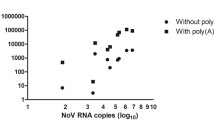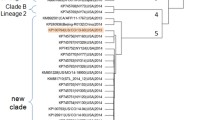Abstract
Noroviruses are among the major causative agents of human acute gastroenteritis, and the nature of norovirus outbreaks can differ considerably. The number of single-nucleotide polymorphisms (SNPs) between strains is used to assess their relationships. There is currently no universally accepted cutoff value for clustering strains that define an outbreak or linking the individuals involved. This study was conducted to estimate the threshold value of genomic variations among related strains within norovirus outbreaks. We carried out a literature search in the PubMed and Web of Science databases. SNP rates were defined as the number of SNPs/sequence length (bp) × 100%. The Mann-Whitney U-test was used in comparisons of the distribution of SNP rates for different sequence regions, genogroups (GI and GII), transmission routes, and sequencing methods. A total of 25 articles reporting on 108 norovirus outbreaks were included. In 99.1% of the outbreaks, the SNP rates were below 0.50%, and in 89.8%, the SNP rates were under 0.20%. Outbreak strains showed higher SNP rates when the P2 domain was used for sequence analysis (Z = -2.652, p = 0.008) and when an NGS method was used (Z = -3.686, p < 0.001). Outbreaks caused by different norovirus genotypes showed no significant difference in SNP rates. Compared with person-to-person outbreaks, SNP rates were lower in common-source outbreaks, but no significant difference was found when differences in sequencing methods were taken into consideraton. SNP rates under 0.20% and 0.50% could be considered as the rigorous and relaxed threshold, respectively, of strain similarity within a norovirus outbreak. More data are needed to evaluate differences within and between various norovirus outbreaks.






Similar content being viewed by others
References
Ahmed SM, Hall AJ, Robinson AE, Verhoef L, Premkumar P, Parashar UD, Koopmans M, Lopman BA (2014) Global prevalence of norovirus in cases of gastroenteritis: a systematic review and meta-analysis. Lancet Infect Dis 14:725–730. https://doi.org/10.1016/S1473-3099(14)70767-4
Bartsch SM, Lopman BA, Ozawa S, Hall AJ, Lee BY (2016) Global Economic Burden of Norovirus Gastroenteritis. PLoS ONE 11:e0151219. https://doi.org/10.1371/journal.pone.0151219
Xi JN, Graham DY, Wang KN, Estes MK (1990) Norwalk virus genome cloning and characterization. Science 250:1580–1583. https://doi.org/10.1126/science.2177224
Hardy ME (2005) Norovirus protein structure and function. FEMS Microbiol Lett 253:1–8. https://doi.org/10.1016/j.femsle.2005.08.031
Steinhauer DA, Domingo E, Holland JJ (1992) Lack of evidence for proofreading mechanisms associated with an RNA virus polymerase. Gene 122:281–288. https://doi.org/10.1016/0378-1119(92)90216-c
Smith EC, Sexton NR, Denison MR (2014) Thinking Outside the Triangle: Replication Fidelity of the Largest RNA Viruses. Annu Rev Virol 1:111–132. https://doi.org/10.1146/annurev-virology-031413-085507
Tan M, Huang P, Meller J, Zhong W, Farkas T, Jiang X (2003) Mutations within the P2 domain of norovirus capsid affect binding to human histo-blood group antigens: evidence for a binding pocket. J Virol 77:12562–12571. https://doi.org/10.1128/jvi.77.23.12562-12571.2003
Cao S, Lou Z, Tan M, Chen Y, Liu Y, Zhang Z, Zhang XC, Jiang X, Li X, Rao Z (2007) Structural basis for the recognition of blood group trisaccharides by norovirus. J Virol 81:5949–5957. https://doi.org/10.1128/JVI.00219-07
Lochridge VP, Hardy ME (2007) A single-amino-acid substitution in the P2 domain of VP1 of murine norovirus is sufficient for escape from antibody neutralization. J Virol 81:12316–12322. https://doi.org/10.1128/JVI.01254-07
Cates JE, Vinjé J, Parashar U, Hall AJ (2020) Recent advances in human norovirus research and implications for candidate vaccines. Expert Rev Vaccines 19:539–548. https://doi.org/10.1080/14760584.2020.1777860
Chhabra P, de Graaf M, Parra GI, Chan MC, Green K, Martella V, Wang Q, White PA, Katayama K, Vennema H, Koopmans MPG, Vinjé J (2019) Updated classification of norovirus genogroups and genotypes. J Gen Virol 100:1393–1406. https://doi.org/10.1099/jgv.0.001318
Liao Q, Ran L, Jin M, Cui S, Yuan J, Ma H, Ban H, Sun L, Luo L, Liu N, Duan Z, Yu H (2016) [Guidelines on outbreak investigation, prevention and control of norovirus infection (2015)]. Zhonghua Yu Fang Yi Xue Za Zhi 50:7–16. https://doi.org/10.3760/cma.j.issn.0253-9624.2016.01.003
Bonifait L, Charlebois R, Vimont A, Turgeon N, Veillette M, Longtin Y, Jean J, Duchaine C (2015) Detection and quantification of airborne norovirus during outbreaks in healthcare facilities. Clin Infect Dis 61:299–304. https://doi.org/10.1093/cid/civ321
Maunula L, Kaupke A, Vasickova P, Söderberg K, Kozyra I, Lazic S, van der Poel WH, Bouwknegt M, Rutjes S, Willems KA, Moloney R, D'Agostino M, de Roda Husman AM, von Bonsdorff CH, Rzeżutka A, Pavlik I, Petrovic T, Cook N (2013) Tracing enteric viruses in the European berry fruit supply chain. Int J Food 167:177–185. https://doi.org/10.1016/j.ijfoodmicro.2013.09.003
Sukhrie FH, Beersma MF, Wong A, van der Veer B, Vennema H, Bogerman J, Koopmans M (2011) Using molecular epidemiology to trace transmission of nosocomial norovirus infection. J Clin Microbiol 49:602–606
Höhne M, Niendorf S, Mas Marques A, Bock CT (2015) Use of sequence analysis of the P2 domain for characterization of norovirus strains causing a large multistate outbreak of norovirus gastroenteritis in Germany 2012. Int J Med Microbiol 305:612–618. https://doi.org/10.1016/j.ijmm.2015.08.010
Sukhrie FH, Teunis P, Vennema H, Bogerman J, van Marm S, Beersma MF, Koopmans M (2013) P2 domain profiles and shedding dynamics in prospectively monitored norovirus outbreaks. J Clin Virol 56:286–292. https://doi.org/10.1016/j.jcv.2012.12.006
Xerry J, Gallimore CI, Iturriza-Gómara M, Gray JJ (2009) Tracking the transmission routes of genogroup II noroviruses in suspected food-borne or environmental outbreaks of gastroenteritis through sequence analysis of the P2 domain. J Med Virol 81:1298–1304. https://doi.org/10.1002/jmv.21517
Casto AM, Adler AL, Makhsous N, Crawford K, Qin X, Kuypers JM, Huang ML, Zerr DM, Greninger AL (2019) Prospective, Real-time Metagenomic Sequencing During Norovirus Outbreak Reveals Discrete Transmission Clusters. Clin Infect Dis 69:941–948. https://doi.org/10.1093/cid/ciy1020
Stimson J, Gardy J, Mathema B, Crudu V, Cohen T, Colijn C (2019) Beyond the SNP Threshold: Identifying Outbreak Clusters Using Inferred Transmissions. Mol Biol Evol 36:587–603. https://doi.org/10.1093/molbev/msy242
Octavia S, Wang Q, Tanaka MM, Kaur S, Sintchenko V, Lan R (2015) Delineating community outbreaks of Salmonella enterica serovar Typhimurium by use of whole-genome sequencing: insights into genomic variability within an outbreak. J Clin Microbiol 53:1063–1071. https://doi.org/10.1128/JCM.03235-14
Hatherell HA, Colijn C, Stagg HR, Jackson C, Winter JR, Abubakar I (2016) Interpreting whole genome sequencing for investigating tuberculosis transmission: a systematic review. BMC Med 14:21. https://doi.org/10.1186/s12916-016-0566-x
Humphreys H, Coleman DC (2019) Contribution of whole-genome sequencing to understanding of the epidemiology and control of meticillin-resistant Staphylococcus aureus. J Hosp Infect 102:189–199. https://doi.org/10.1016/j.jhin.2019.01.025
Smith CR, Enns C, Cutfeet D, Alfred S, James N, Lindbeck J, Russell S (2021) COVID-19 in a remote First Nations community in British Columbia, Canada: an outbreak report. CMAJ open 9:E1073–E1079. https://doi.org/10.9778/cmajo.20210054
Xue KS, Bloom JD (2020) Linking influenza virus evolution within and between human hosts. Virus Evol 6:veaa010. https://doi.org/10.1093/ve/veaa010
Lorenzo-Redondo R, Ozer EA, Achenbach CJ, D'Aquila RT, Hultquist JF (2021) Molecular epidemiology in the HIV and SARS-CoV-2 pandemics. Curr Opin HIV AIDS 16:11–24. https://doi.org/10.1097/COH.0000000000000660
Moher D, Liberati A, Tetzlaff J, Altman DG (2009) Preferred reporting items for systematic reviews and meta-analyses: the PRISMA statement. BMJ 339:b2535. https://doi.org/10.1136/bmj.b2535
Field N, Cohen T, Struelens MJ, Palm D, Cookson B, Glynn JR, Gallo V, Ramsay M, Sonnenberg P, Maccannell D, Charlett A, Egger M, Green J, Vineis P, Abubakar I (2014) Strengthening the Reporting of Molecular Epidemiology for Infectious Diseases (STROME-ID): an extension of the STROBE statement. Lancet Infect Dis 14:341–352. https://doi.org/10.1016/S1473-3099(13)70324-4
Division of Viral Diseases, National Center for Immunization and Respiratory Diseases, Centers for Disease Control and Prevention (2011) Updated norovirus outbreak management and disease prevention guidelines. MMWR Recomm Rep 60:1–18
Schwartz S, Vergoulidou M, Schreier E, Loddenkemper C, Reinwald M, Schmidt-Hieber M, Flegel WA, Thiel E, Schneider T (2011) Norovirus gastroenteritis causes severe and lethal complications after chemotherapy and hematopoietic stem cell transplantation. Blood 117:5850–5856. https://doi.org/10.1182/blood-2010-12-325886
Sukhrie FH, Teunis P, Vennema H, Bogerman J, van Marm S, Beersma MF, Koopmans M (2013) P2 domain profiles and shedding dynamics in prospectively monitored norovirus outbreaks. J Clin Virol 56:286–292. https://doi.org/10.1016/j.jcv.2012.12.006
Fonager J, Stegger M, Rasmussen LD, Poulsen MW, Rønn J, Andersen PS, Fischer TK (2017) A universal primer-independent next-generation sequencing approach for investigations of norovirus outbreaks and novel variants. Sci Rep 7:813. https://doi.org/10.1038/s41598-017-00926-x
Hasing ME, Hazes B, Lee BE, Preiksaitis JK, Pang XL (2016) A next generation sequencing-based method to study the intra-host genetic diversity of norovirus in patients with acute and chronic infection. BMC Genomics 1;17:480. https://doi.org/10.1186/s12864-016-2831-y
Nasheri N, Petronella N, Ronholm J, Bidawid S, Corneau N (2017) Characterization of the Genomic Diversity of Norovirus in Linked Patients Using a Metagenomic Deep Sequencing Approach. Front Microbiol 31:8:73. https://doi.org/10.3389/fmicb.2017.00073
Gilles A, Meglécz E, Pech N, Ferreira S, Malausa T, Martin JF (2011) Accuracy and quality assessment of 454 GS-FLX Titanium pyrosequencing. BMC Genomics 19:12:245. https://doi.org/10.1186/1471-2164-12-245
Lopman B, Vennema H, Kohli E, Pothier P, Sanchez A, Negredo A, Buesa J, Schreier E, Reacher M, Brown D, Gray J, Iturriza M, Gallimore C, Bottiger B, Hedlund KO, Torvén M, von Bonsdorff CH, Maunula L, Poljsak-Prijatelj M, Zimsek J, Reuter G, Szücs G, Melegh B, Svennson L, van Duijnhoven Y, Koopmans M (2004) Increase in viral gastroenteritis outbreaks in Europe and epidemic spread of new norovirus variant. Lancet 363:682–688. https://doi.org/10.1016/S0140-6736(04)15641-9
Eden JS, Bull RA, Tu E, McIver CJ, Lyon MJ, Marshall JA, Smith DW, Musto J, Rawlinson WD, White PA (2010) Norovirus GII.4 variant 2006b caused epidemics of acute gastroenteritis in Australia during 2007 and 2008. J Clin Virol 49:265–271. https://doi.org/10.1016/j.jcv.2010.09.001
Yen C, Wikswo ME, Lopman BA, Vinje J, Parashar UD, Hall AJ (2011) Impact of an emergent norovirus variant in 2009 on norovirus outbreak activity in the United States. Clin Infect Dis 53:568–571. https://doi.org/10.1093/cid/cir478
Burke RM, Shah MP, Wikswo ME, Barclay L, Kambhampati A, Marsh Z, Cannon JL, Parashar UD, Vinjé J, Hall AJ (2016) The Norovirus Epidemiologic Triad: Predictors of Severe Outcomes in US Norovirus Outbreaks, 2009–2016. J Infect Dis 219:1364–1372. https://doi.org/10.1093/infdis/jiy569
Parra GI, Squires RB, Karangwa CK, Johnson JA, Lepore CJ, Sosnovtsev SV, Green KY (2017) Static and Evolving Norovirus Genotypes: Implications for Epidemiology and Immunity. PLoS Pathog 13:e1006136. https://doi.org/10.1371/journal.ppat.1006136
Dingle KE, Norovirus Infection Control in Oxfordshire Communities Hospitals (2004) Mutation in a Lordsdale norovirus epidemic strain as a potential indicator of transmission routes. J Clin Microbiol 42:3950–3957. https://doi.org/10.1128/JCM.42.9.3950-3957.2004
Bull RA, Eden JS, Luciani F, McElroy K, Rawlinson WD, White PA (2012) Contribution of intra- and interhost dynamics to norovirus evolution. J Virol 86:3219–3229. https://doi.org/10.1128/JVI.06712-11
Octavia S, Wang Q, Tanaka MM, Kaur S, Sintchenko V, Lan R (2015) Delineating community outbreaks of Salmonella enterica serovar Typhimurium by use of whole-genome sequencing: insights into genomic variability within an outbreak. J Clin Microbiol 53:1063–1071. https://doi.org/10.1128/JCM.03235-14
Walker TM, Ip CL, Harrell RH, Evans JT, Kapatai G, Dedicoat MJ, Eyre DW, Wilson DJ, Hawkey PM, Crook DW, Parkhill J, Harris D, Walker AS, Bowden R, Monk P, Smith EG, Peto TE (2013) Whole-genome sequencing to delineate Mycobacterium tuberculosis outbreaks: a retrospective observational study. Lancet Infect Dis 13:137–146. https://doi.org/10.1016/S1473-3099(12)70277-3
Funding
This work was supported by the Medical Scientific Research Project of Jiangsu Provincial Health Commission (grant number H2019019).
Author information
Authors and Affiliations
Contributions
L.T., X.Z., X.W.: literature review, data extraction. L.T., J.D.: methodology. L.T.: software, formal analysis, visualization, writing – original draft. J.D.: conceptualization, project administration, funding acquisition, supervision, validation, writing – review & editing.
Corresponding author
Ethics declarations
Conflict of interest
The authors have no relevant financial or non-financial interests to disclose.
Additional information
Communicated by Akbar Dastjerdi
Publisher’s Note
Springer Nature remains neutral with regard to jurisdictional claims in published maps and institutional affiliations.
Electronic Supplementary Material
Below is the link to the electronic supplementary material
Rights and permissions
Springer Nature or its licensor (e.g. a society or other partner) holds exclusive rights to this article under a publishing agreement with the author(s) or other rightsholder(s); author self-archiving of the accepted manuscript version of this article is solely governed by the terms of such publishing agreement and applicable law.
About this article
Cite this article
Tao, L., Zhang, X., Wang, X. et al. Using molecular methods to delineate norovirus outbreaks: a systematic review. Arch Virol 169, 16 (2024). https://doi.org/10.1007/s00705-023-05953-w
Received:
Accepted:
Published:
DOI: https://doi.org/10.1007/s00705-023-05953-w




